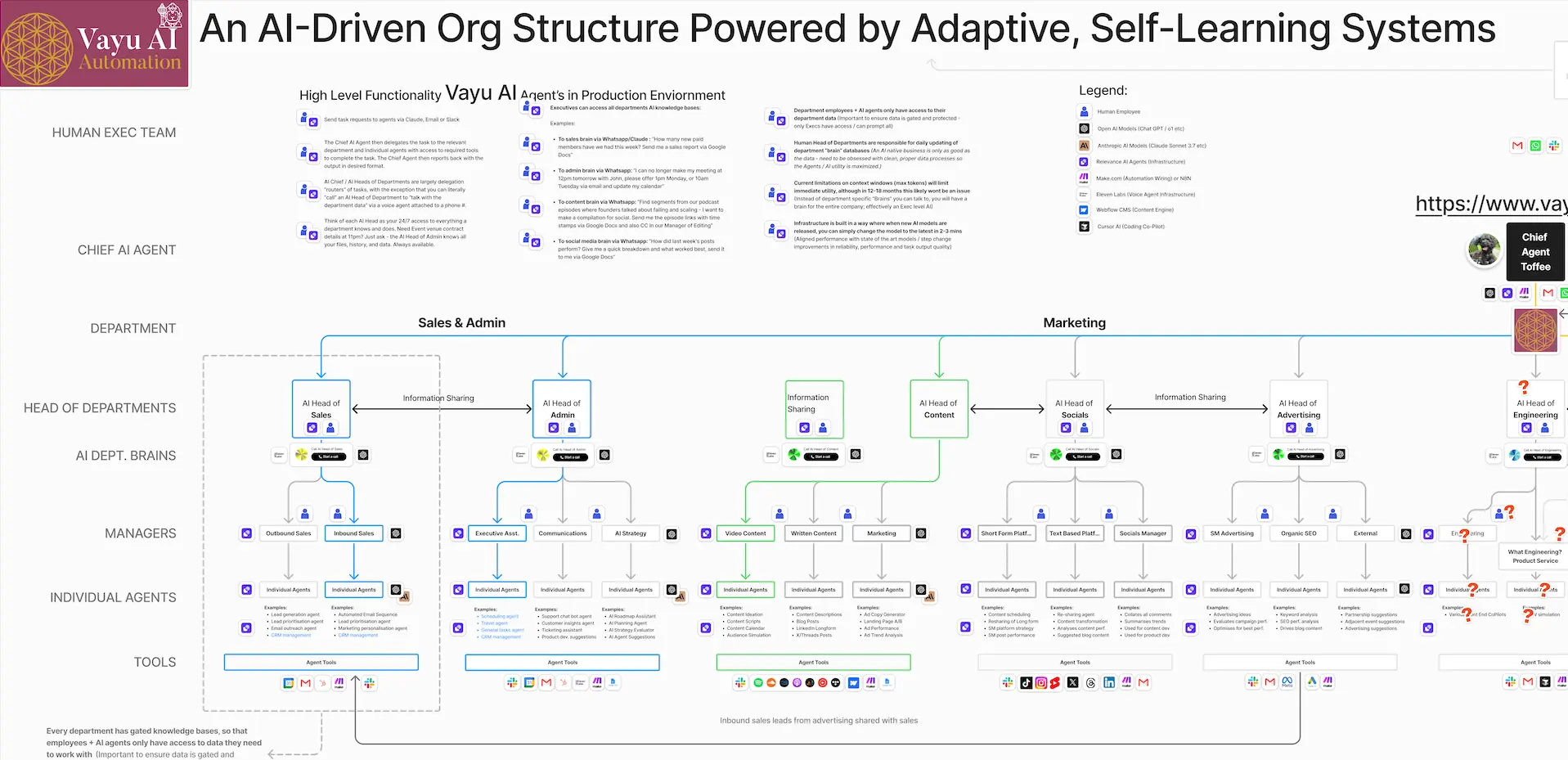Designing the Future: An AI-Driven Organizational Structure

An AI-Driven Organizational Structure Powered by Adaptive, Self-Learning Systems
What if an entire organization could be run using AI agents — not just for automation, but with adaptive, evolving intelligence at its core?
What started as a sketch on paper has slowly evolved into a working model — one where AI tools don’t just assist tasks, but where agents think, delegate, coordinate, and learn across departments. It’s still a work in progress, but it felt like the right time to share it.
“AI should free humans for higher-order work.”
That line has been a north star for me. It’s not just about saving time — it’s about creating space for creativity, strategy, and alignment.
Sharing This Openly
What you’ll see below is a visual map of the internal structure I’ve been building at Vayu AI Automation — a framework for how a fully AI-driven company might function across Sales, Admin, Marketing, Product, HR, and more.
Click here to view/download the chart
🫶 I’m sharing this publicly because I deeply believe in open-source knowledge, and because so many of us are exploring similar paths right now.
Why I Built It
This wasn’t about showcasing tech. It was about asking:
- What if AI could take over operational complexity without losing human nuance?
- What if teams could scale without scaling burnout?
- What would a modular, agent-led organization really look like — and how would it function day-to-day?
The chart is my current answer.
It shows:
- AI Heads leading departments
- Task-specific agents operating under those leads
- Role-gated tools and knowledge bases
- Clear pathways for information to move across teams
There’s nothing theoretical here — this is how I’ve started wiring systems together for my own work and collaborations.
Behind the Design
Here’s how it works:
- A Chief AI Agent acts as the delegation layer — it receives task requests via Slack, Claude, WhatsApp, or email.
- It routes those to the right AI Head (Sales, Admin, Content, etc.)
- Each AI Head passes the task to individual agents trained for execution: outreach, scheduling, SEO, editing, design prompts — even event logistics or HR onboarding.
- Responses are returned in human-readable, action-ready formats (e.g., emails, documents, content drafts, or task completions)
Everything is built on:
- GPT-4, Claude, Make (n8n), Notion, Google, Slack, etc.
- With privacy and scope control — agents can only access the tools/data they need for their role
Think of it like a living nervous system of modular intelligence, not just scripts or bots.
Department Breakdown
The structure currently includes:
- Sales & Admin: AI Heads for CRM, outbound, inbound, communication assistants
- Marketing: Split into Content, Socials, and Advertising, each with dedicated agents for content generation, repurposing, and analytics
- Product: Still evolving, but grounded in deep-learning integration, product prompts, and early design tools
- Back Office: Finance, HR, and Management functions, each mapped to AI assistants for things like payroll, training, recruiting, and event planning
- Customer: Includes multilingual support agents and customer success logic that works asynchronously
Privacy & Responsibility
Every department has gated knowledge bases — both for privacy and clarity.
Only the Exec layer (or Chief AI Agent) can prompt across departments. This ensures tasks remain scoped, and that outputs remain relevant and safe.
Humans still play a critical role: not just in prompting and feedback, but in maintaining the quality of the underlying data that these agents learn from.
Where It’s Going Next
There are still unknowns.
Context windows. Agent memory. Model switching. Interoperability.
I’m exploring them all — and learning as I go.
But I hope this chart helps paint a clearer picture for anyone building in this space, especially those asking:
“What does an AI-powered business actually look like under the hood?”
This is mine. And I’d love to see yours too.
Let’s Learn Together
I’m not trying to sell anything here. I’m trying to understand this world better — and I know many of you are too.
If this sparks questions, feedback, or curiosity, feel free to reach out.
Let’s keep building with intention.
This post was tagged in:
- #AI
- #org design
- #workflow automation
- #adaptive systems